Spring is in the air, and with that comes flowers and insects. It’s also the time of year that the bees begin to emerge! Bees are remarkable creatures and are a joy to photograph. With a little patience and setup, you can have fun with bee photography, too.
Camera and lens options for bee photography
You can use almost any camera and lens to create bee photos, but certain types of gear will likely result in better (and more predictable) results. Here is the gear that I recommend using for close-up bee photography:
- Interchangeable lens camera: An interchangeable lens camera, such as a mirrorless or DSLR, will allow you the most flexibility with your setup and will allow you to use a close-focus macro lens.
- Macro lens: A macro lens will allow you to get close to the bees and get all the tiny details of the bee’s eyes, wings, antennae, pollen, and more.
.mgl-tiles { display: none; } #mgl-gallery-634ecdb5ead74 { margin: -5px; width: calc(100% + 10px); } #mgl-gallery-634ecdb5ead74 .mgl-box { padding: 5px; } @media screen and (max-width: 768px) { #mgl-gallery-634ecdb5ead74 { margin: -5px; width: calc(100% + 10px); } #mgl-gallery-634ecdb5ead74 .mgl-box { padding: 5px; } } @media screen and (max-width: 460px) { #mgl-gallery-634ecdb5ead74 { margin: -5px; width: calc(100% + 10px); } #mgl-gallery-634ecdb5ead74 .mgl-box { padding: 5px; } }
A macro lens works best for bee photography.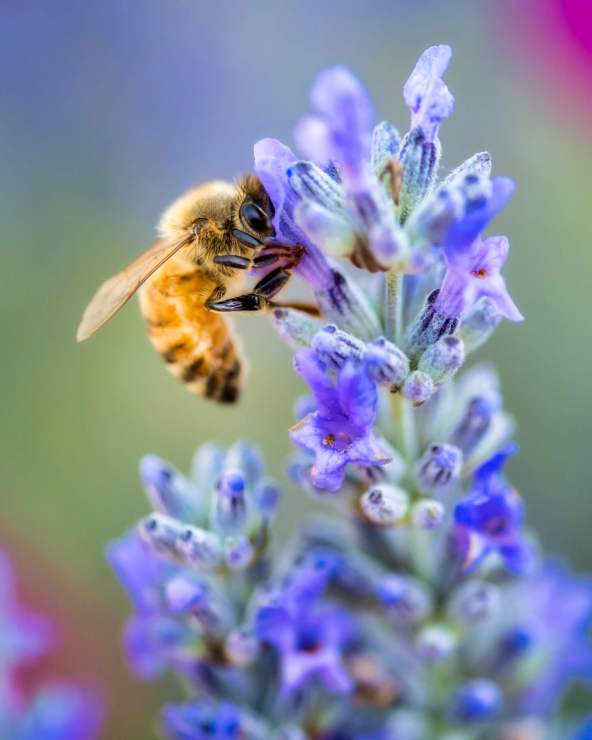
A macro lens works best for bee photography.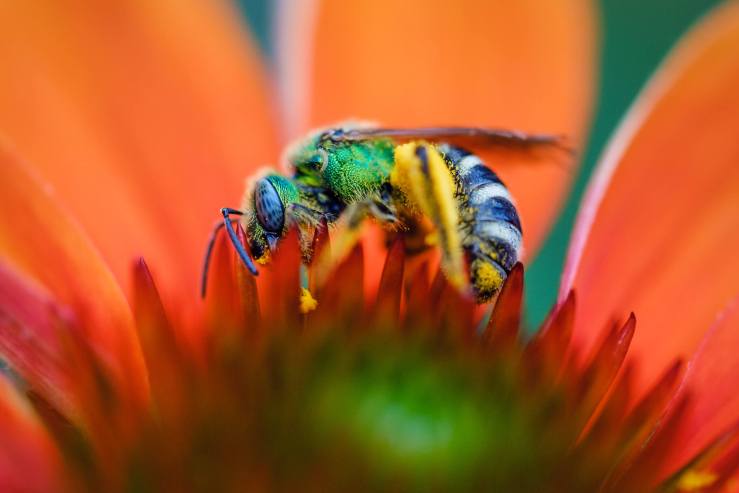
Camera settings
When setting the camera, you want to make sure that the shutter speed is fast (to prevent motion), and a large aperture can also help blur the background. Here are the settings I recommend:
- Shutter speed: Bees move fast, so you’ll want to use a fast shutter speed. I typically set my shutter speed to around 1/1000th of a second, which is usually enough to freeze the bee movement as it is moving around on the flowers (or, if you’re lucky, a good capture of it midair!).
- Aperture: A wide aperture setting (whatever the widest setting is on your lens) is usually a good place to start when photographing bees. A wide aperture will allow you to work with a faster shutter speed, and it will also help blur the background.
- ISO: I recommend setting the ISO to “auto” since you will likely have your shutter speed and aperture already dialed in and set where you want it. If you have enough light, a higher ISO will still give you grain, but so long as your exposure is not underexposed, you will still end up with great quality images.
- Shutter type: If you are using a mirrorless camera, make sure you set your shutter type to a “mechanical” shutter. Using an electronic shutter can add strange effects to moving objects, especially the bee’s wings if you happen to catch them in flight (or starting to fly).
.mgl-tiles { display: none; } #mgl-gallery-634ecdb5ebb21 { margin: -5px; width: calc(100% + 10px); } #mgl-gallery-634ecdb5ebb21 .mgl-box { padding: 5px; } @media screen and (max-width: 768px) { #mgl-gallery-634ecdb5ebb21 { margin: -5px; width: calc(100% + 10px); } #mgl-gallery-634ecdb5ebb21 .mgl-box { padding: 5px; } } @media screen and (max-width: 460px) { #mgl-gallery-634ecdb5ebb21 { margin: -5px; width: calc(100% + 10px); } #mgl-gallery-634ecdb5ebb21 .mgl-box { padding: 5px; } }
If using a mirrorless camera, be sure to turn OFF the “Electronic shutter” to prevent warping wing movement (as seen in this image).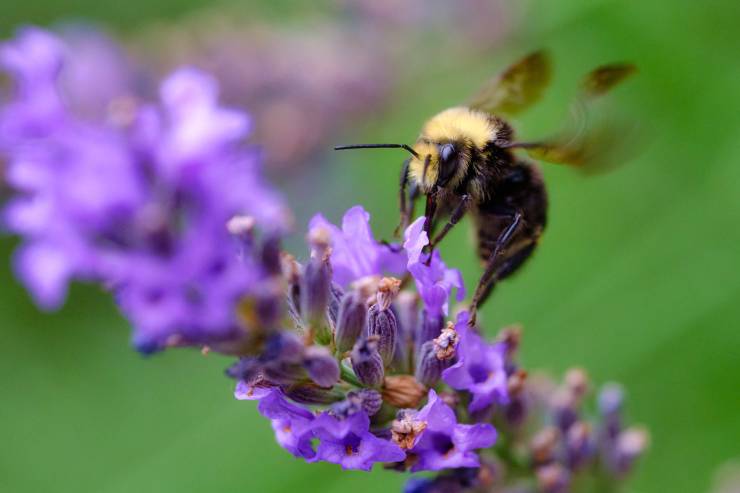
Bees move quickly, so make sure you have a fast-enough shutter speed set to prevent motion blur.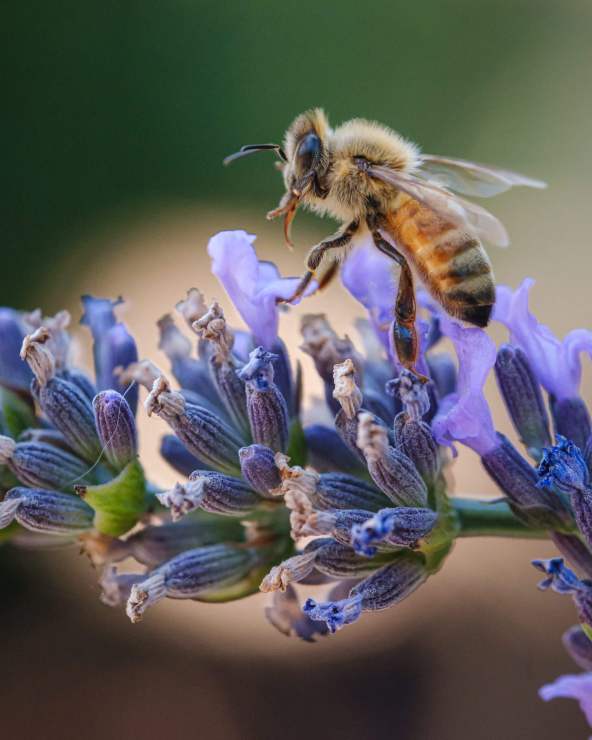
Focusing
Focusing is going to be your biggest challenge since the bees move very quickly and you will constantly be changing your focus distance. The important thing to remember is that the goal is to set the bee’s eyes as the focal point; if the eyes are in focus, then the rest of the bee, background, and foreground can fall out of focus. Here’s how to work with both auto and manual focus when photographing bees:
- Autofocus: If you have a fast-focusing lens, you can try using autofocus. It can still be tricky, however, since bees can move really fast. Do your best to get the eyes in focus when setting up your shot.
- Manual focus: Another option is to pre-focus your lens to a specific distance (usually a distance that will fill the frame with the bee and surroundings to your liking when it is in focus). Then, simply move the camera back and forth on a bee to find the focus
It might also be helpful to set your camera to a high frame rate or burst shot mode (multiple frames per second). You’ll create a lot of throwaways, but you’re more likely to get one or two photos with the bee in focus and composed well.
.mgl-tiles { display: none; } #mgl-gallery-634ecdb5ec528 { margin: -5px; width: calc(100% + 10px); } #mgl-gallery-634ecdb5ec528 .mgl-box { padding: 5px; } @media screen and (max-width: 768px) { #mgl-gallery-634ecdb5ec528 { margin: -5px; width: calc(100% + 10px); } #mgl-gallery-634ecdb5ec528 .mgl-box { padding: 5px; } } @media screen and (max-width: 460px) { #mgl-gallery-634ecdb5ec528 { margin: -5px; width: calc(100% + 10px); } #mgl-gallery-634ecdb5ec528 .mgl-box { padding: 5px; } }
The eyes are the most important part to focus on.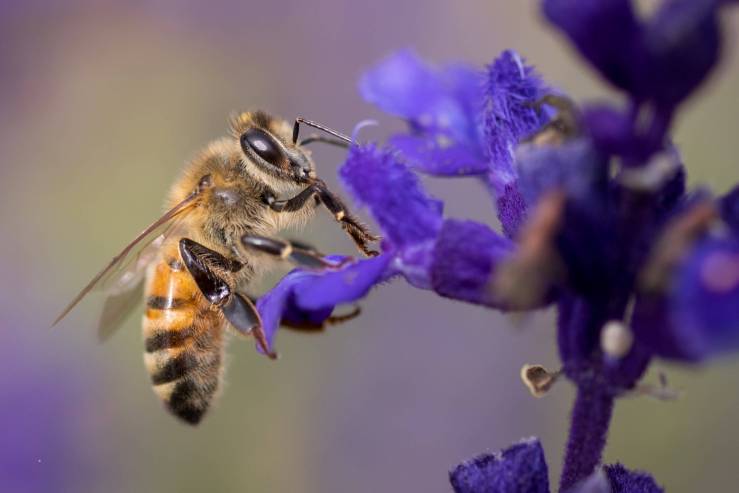
The eyes are the most important part to focus on.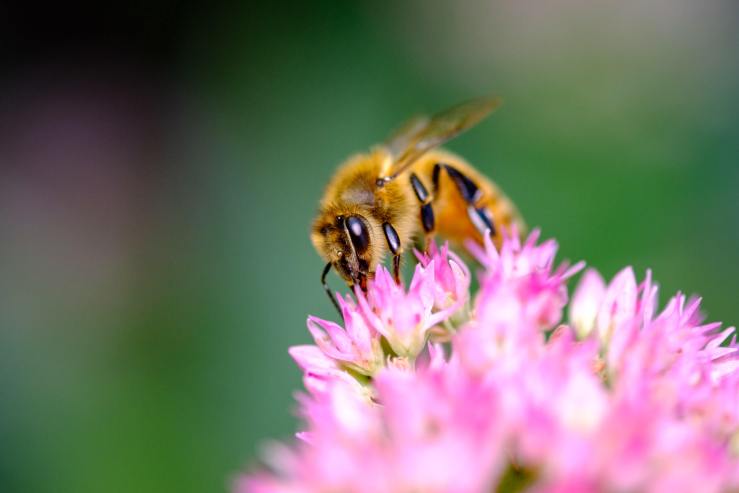
Lighting for bee photography
When photographing small macro images, such as bees, diffused light will work best. This can be positioning yourself in the shade, or photographing on an overcast day.
If you’re out on a sunny day, try bringing a small pop-up diffuser to shade the bees with (or use your body to block the sunlight). Even in the shade, if it’s really bright outside, you will still have a LOT of light to work with.
However, if you can’t add diffusion to your images, try positioning yourself so that the bees are backlit by the sun. With this type of light, you can get some interesting rim-light effects along the outside edge of the bee, and if the light hits it just right, it can even make the bee glow.
.mgl-tiles { display: none; } #mgl-gallery-634ecdb5ecfea { margin: -5px; width: calc(100% + 10px); } #mgl-gallery-634ecdb5ecfea .mgl-box { padding: 5px; } @media screen and (max-width: 768px) { #mgl-gallery-634ecdb5ecfea { margin: -5px; width: calc(100% + 10px); } #mgl-gallery-634ecdb5ecfea .mgl-box { padding: 5px; } } @media screen and (max-width: 460px) { #mgl-gallery-634ecdb5ecfea { margin: -5px; width: calc(100% + 10px); } #mgl-gallery-634ecdb5ecfea .mgl-box { padding: 5px; } }
If you have bright sunlight, try back-lighting the bee to add rim-light and glow.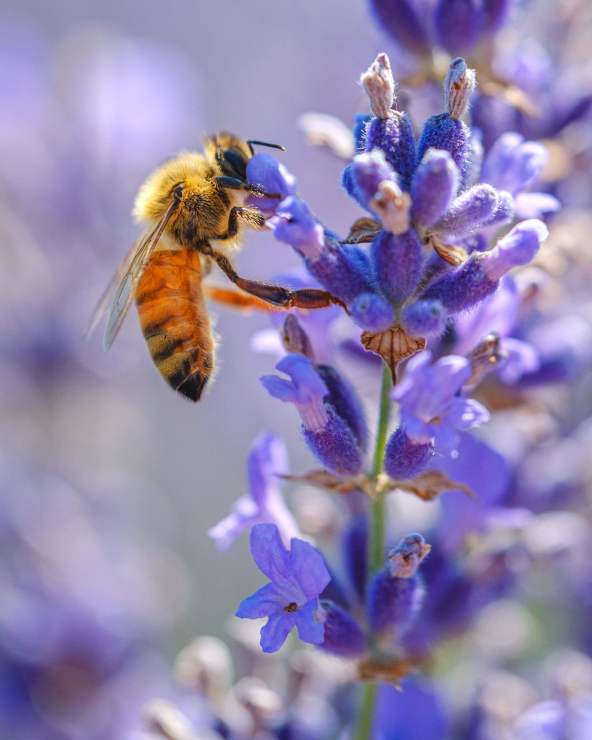
Diffused sunlight will light the subject evenly.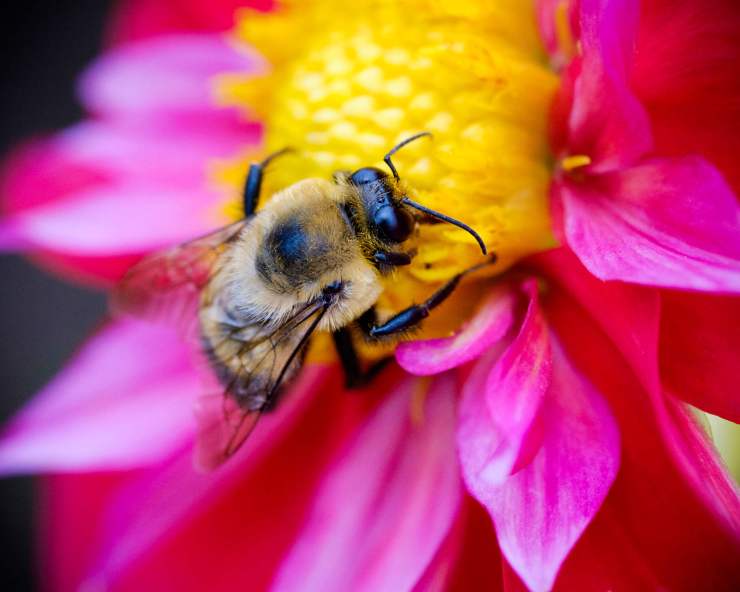
Composition
Don’t let the excitement of photographing bees overcome your desire to create a well-composed shot! As with most forms of photography, general compositional concepts — such as the rule of thirds — will do justice to your images. Here are a few more tips specific to bee photography that you might also find helpful:
- Background considerations: A clean, uncluttered backdrop will give you the best results. The best way to ensure a great setup is to find a spot (such as a flower with a good backdrop, then sit and wait. If there are a lot of bees swarming around the flowers, eventually one will land on the spot you are waiting for.
- The bee’s angle: Try photographing the bee from its side, so that you are viewing its profile. This shows more interesting details of all elements of the bee’s body, and you’re more likely to see the eyes clearly. Try avoiding photographing the bee from behind. I find that taller flowers (such as lavender) are a great flower to use because the bees will typically be vertical when it lands on the flower.
.mgl-tiles { display: none; } #mgl-gallery-634ecdb5ed89c { margin: -5px; width: calc(100% + 10px); } #mgl-gallery-634ecdb5ed89c .mgl-box { padding: 5px; } @media screen and (max-width: 768px) { #mgl-gallery-634ecdb5ed89c { margin: -5px; width: calc(100% + 10px); } #mgl-gallery-634ecdb5ed89c .mgl-box { padding: 5px; } } @media screen and (max-width: 460px) { #mgl-gallery-634ecdb5ed89c { margin: -5px; width: calc(100% + 10px); } #mgl-gallery-634ecdb5ed89c .mgl-box { padding: 5px; } }
A clean, green background helps to separate the bee and make it stand out.
Even a simple backdrop (like this pink dahlia) works well to add separation.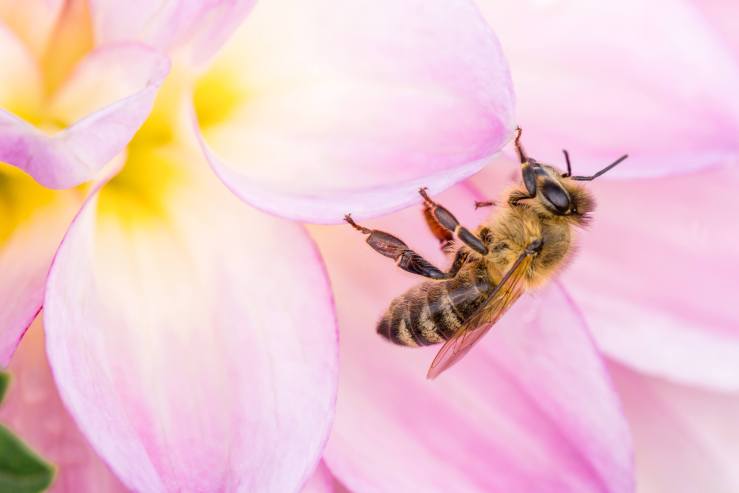
This background is simple and makes the bee stand out.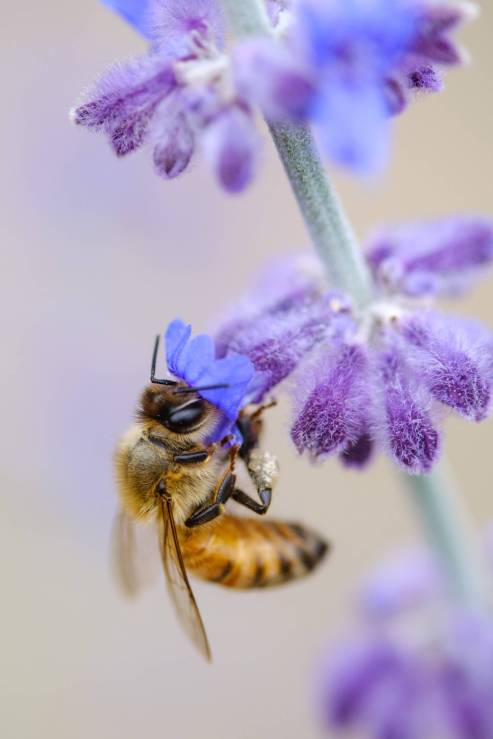
Tell your story with the second annual Visual Storytelling Conference!
Experience four days of interactive, online training sessions featuring a range of educational content with experienced photographers and content creators. This free event kicks off with a series of technical boot camps to build essential skills, followed by live, online sessions on photography, video, business and social media. Join live from March 10-13, 2022!
